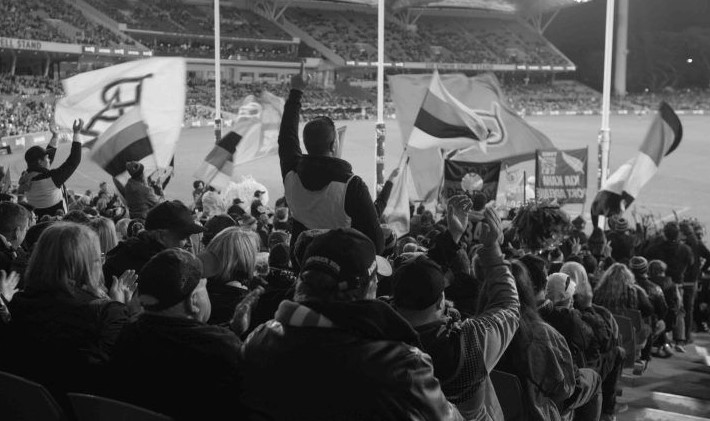The world may remember 2020 as the year when COVID-19 took hold, but it was much more to fans of the Port Adelaide Football Club.
The pandemic disruption coincided with the organisation’s 150th anniversary, making for a milestone unlike any other.
The true extent of how the season impacted the club is captured in Nicole Miller’s documentary This is Port Adelaide, which chronicles the team’s rise up the SANFL and AFL, while exploring how its rich history has helped shape the identity of the Port Adelaide community.
Stories are shared from the players that have tasted success in the guernsey, and the supporters that take every opportunity to show their loyalty.
This is Port Adelaide was produced by Miller, James Moody and Paul Ryan for 57 Fims, with Ryan executive producing alongside Daniel Norton and Justin Kurzel.
Kurzel (Snowtown, The True History of the Kelly Gang) also mentored Miller on the project.
The Adelaide Film Festival Investment Fund film was financed with assistance from South Australian Film Corporation and support from the Port Adelaide Football Club.
It’s not the first time Miller has worked with the club, having produced and directed The AFL Show in 2016. The 25-episode series, designed to introduce football to a Chinese audience off the back of Port Adelaide’s decision to engage with the country two years earlier, was broadcast on CCTV5+ to audiences across the country.
She also produced and directed the pilot program Power Dreaming, which examined how the programs run by the PAFC played a role in driving positive change for Indigenous youth in Australia.
Miller said the idea for a feature-length documentary developed organically out of discussions about ways to celebrate the club’s 150th year.
“The first conversation around it was toward the end of 2018, knowing the 150th milestone was coming up and we wanted to do some project to mark that anniversary,” she said.
“Over the course of the next year, we began filming some staff of the club almost as a bit of action research.
“Initially, we wanted to make it as a television special, but during 2019, we realised we could tell a bigger story, and that’s where the film focus came from.”
What was supposed to be a season of triumph for the club and its supporters soon became one of uncertainty, however, as the spread of COVID-19 forced the postponement of games after Round One, with teams returning to play in front of empty stadiums.
There was more hurt for Port Adelaide in May when it was announced the Port Adelaide Magpies reserve side – winner of 36 premierships – had been barred from playing the SANFL season for the first time in history due to restrictions.
Miller said while she was initially worried about the impact the pandemic would have on filming, the response from those involved in the club allowed her to bring the project’s central ideas to the fore.
“We’d already embarked on telling a story which was taking the form of telling the history of that community and showing the modern side of it and how those values have carried through,” she said.
“Then COVID happened and we wondered where that left us.
“We took a step back and said, ‘Well, we are documentary filmmakers and this is what’s happening in the club’s 150th year’.
“It speaks to the theme of what club means to these people and how it can keep people connected from a modern perspective, even more than if we were telling a straight history of the club, or they had just had a regular season.”
The film was initially due to premiere last November but the date was postponed due to the hard COVID-19 lockdown in South Australia at the time, with the first screenings instead taking place from February 5 to 7 at the Odeon Cinema, Semaphore.
The documentary will be released in cinemas nationally from April 22, with Q&A event screenings from April 16.
Miller said the feedback she had received so far had indicated the nostalgia in the film was resonating with audiences.
“I grew up in the western suburbs of Adelaide, so there is a bit of a love letter in there, in terms of capturing some of the people and places.
“I think some people can see their own childhoods, or the stories of their own lives.”



